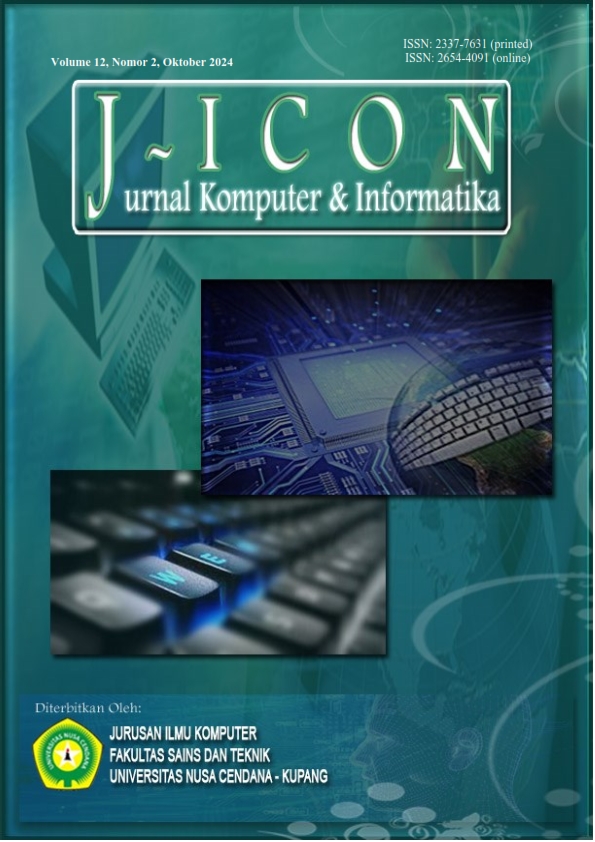GOOGLE TEACHABLE MACHINE: PEMANFAATAN MACHINE LEARNING BERBASIS CNN UNTUK IDENTIFIKASI CEPAT BATUAN MINERAL KALSIT, KUARSA DAN MAGNETIT
Abstract
Google Teachable Machine is a web-based application that allows users to create a machine learning model without the need for coding. The application utilizes Convolutional Neural Networks (CNN) in its process. In this study, Teachable Machine was utilized to create a machine learning model capable of identifying specific mineral rocks, particularly magnetite, calcite, and quartz. The research procedure was conducted through several stages: Sample Collection, Sample Classification (Dataset), Model Training, and Evaluation Process. Sample data in the form of mineral rock images were obtained and downloaded from Google. The data was then divided into three mineral classes: magnetite, calcite, and quartz, which were used as inputs in the Teachable Machine. Model training in Teachable Machine used input epochs of 100, batch size of 64, and learning rate of 0.0001. The results of the Teachable Machine modeling were then evaluated, showing that the obtained model could recognize magnetite, calcite, and quartz minerals with an average accuracy, precision, recall, specificity, and F1-score of 91.11% (86.67%), 87.30%, 86.67%, 93.33%, and 86.50% respectively. This research indicates that the utilization of Teachable Machine assists in quick, accurate, and easy identification, thereby contributing to speeding up the process of mineral rock analysis, decision-making, and exploration strategy development. Additionally, these results demonstrate the potential for broader development of this application in various fields of study.
Downloads
References
Google Creative Lab, “Teachable Machine.” [Online]. Available: https://experiments.withgoogle.com/teachable-machine. [Accessed 24 October 2023].
N. Siddiqui, “Creating Deep Convolutional Neural Networks for Image Classification.” [Online]. Available: https://programminghistorian.org/en/lessons/image-classification-neural-networks. [Accessed 24 October 2023].
Datagen, “Convolutional Neural Network: Benefits, Types, and Applications.” [Online]. Available: https://datagen.tech/guides/computer-vision/cnn-convolutional-neural-network/. [Accessed 24 October 2023].
N. Dewi and F. Ismawan, “Implementasi Deep Learning Menggunakan CNN Untuk Sistem Pengenalan Wajah,” Faktor Exacta, vol. 14, no. 1, pp. 34, Mar 2021, doi: 10.30998/faktorexacta.v14i1.8989.
J. Wang dan Z. Li, “Research on Face Recognition Based on CNN,” in IOP Conference Series: Earth and Environmental Science, Institute of Physics Publishing, Jul 2018. doi: 10.1088/1755-1315/170/3/032110.
M. Arsal, B. A. Wardijono, dan D. Anggraini, “Face Recognition Untuk Akses Pegawai Bank Menggunakan Deep Learning Dengan Metode CNN,” Jurnal Nasional Teknologi dan Sistem Informasi, vol. 6, no. 1, pp. 55–63, Jun 2020, doi: 10.25077/TEKNOSI.V6I1.2020.55-63.
A. Anton, N. F. Nissa, A. Janiati, N. Cahya, dan P. Astuti, “Application of Deep Learning Using Convolutional Neural Network (CNN) Method For Women’s Skin Classification,” Scientific Journal of Informatics, vol. 8, no. 1, pp. 144–153, Mei 2021, doi: 10.15294/sji.v8i1.26888.
N. Sharma, V. Jain, dan A. Mishra, “An Analysis Of Convolutional Neural Networks For Image Classification,” Procedia Comput Sci, vol. 132, pp. 377–384, Jan 2018, doi: 10.1016/J.PROCS.2018.05.198.
J. K. Leonard, “Image Classification and Object Detection Algorithm Based on Convolutional Neural Network,” Science Insights, vol. 31, no. 1, pp. 85–100, Nov 2019, doi: 10.15354/si.19.re117.
Y. H. Natbais dan A. B. S. Umbu, “Aplikasi Deteksi Penyakit pada Daun Tomat Berbasis Android Menggunakan Model Terlatih Tensorflow Lite,” TEKNOTAN, vol. 17, no. 2, pp. 83, Agu 2023, doi: 10.24198/jt.vol17n2.1.
C. Chazar dan M. H. Rafsanjani, “Penerapan Teachable Machine Pada Klasifikasi Machine Learning Untuk Identifikasi Bibit Tanaman,” dalam Seminar Nasional : Inovasi & Adopsi Teknologi , 2022, doi: 10.35969/inotek.v2i1.207.
N. Tri, S. Saptadi, P. Chyan, dan V. M. Widjaja, “Desain Model Klasifikasi Sampah Organik Menjadi Bahan Baku Briket Biomassa Menggunakan Metode Deep Learning,” Jurnal Informatika dan Komputer), vol. 6, no. 2, pp. 160–168, 2022, doi: 10.26798/jiko.v6i2.559.
M. Bagus Baihaqi, Y. Litanianda, dan A. Triyanto, “Implementasi Tensor Flow Lite Pada Teachable Untuk Identifikasi Tanaman Aglonema Berbasis Android,” KOMPUTEK : Jurnal Teknik, vol. 6, no. 1, 2022, [Online]. Available: http://studentjournal.umpo.ac.id/index.php/komputek. [Accessed 24 October 2023].
E. A. U. Malahina, R. P. Hadjon, dan F. Y. Bisilisin, “Teachable Machine: Real-Time Attendance of Students Based on Open Source System,” The IJICS (International Journal of Informatics and Computer Science), vol. 6, no. 3, pp. 140, Nov 2022, doi: 10.30865/ijics.v6i3.4928.
A. Azzam Ajhari, K. Jonathan Sitorus, D. Putri Nur Lyrawati, E. Felix Satria Sridana, R. Lestari, dan W. Vivi Farida, “Noaa Image Classification Using Google’s Teachable Machine,” dalam Seminar Nasional Riset dan Inovasi Teknologi (SEMNAS RISTEK) 2023, 2023, doi: 10.30998/semnasristek.v7i1.6244.
N. A. Baykan dan N. Yilmaz, “Mineral identification using color spaces and artificial neural networks,” Comput Geosci, vol. 36, no. 1, pp. 91–97, Jan 2010, doi: 10.1016/J.CAGEO.2009.04.009.
L. D. Whittig, “X-Ray Diffraction Techniques for Mineral Identification and Mineralogical Composition,” Methods of Soil Analysis, Part 1: Physical and Mineralogical Properties, Including Statistics of Measurement and Sampling, pp. 671–698, Okt 2015, doi: 10.2134/AGRONMONOGR9.1.C49.
J. L. Baldwin, R. M. Bateman, dan C. L. Wheatley, “Application Of A Neural Network To The Problem Of Mineral Identification From Well Logs,” Petrophysics, vol. 31, no. 5, 1990. [Online]. Available: https://onepetro.org/petrophysics/article-abstract/170779/Application-Of-A-Neural-Network-To-The-Problem-Of?redirectedFrom=fulltext. [Accessed 24 Oktober 2023].
S. Aligholi, G. R. Lashkaripour, R. Khajavi, dan M. Razmara, “Automatic mineral identification using color tracking,” Pattern Recognit, vol. 65, pp. 164–174, Mei 2017, doi: 10.1016/J.PATCOG.2016.12.012.
Harkame, “google-images-downloader · PyPI.” [Online]. Available: https://pypi.org/project/google-images-downloader/. [Accessed 25 October 2023].
S. Ghoneim, “Accuracy, Recall, Precision, F-Score & Specificity, which to optimize on?”. [Online]. Available: https://towardsdatascience.com/accuracy-recall-precision-f-score-specificity-which-to-optimize-on-867d3f11124. [Accessed 24 Oktober 2023]
Bharathi, “Latest Guide on Confusion Matrix for Multi-Class Classification.”. [Online]. Available: https://www.analyticsvidhya.com/blog/2021/06/confusion-matrix-for-multi-class-classification/. [Accessed 24 October 2023]
I. Logunova, “A Guide to F1-score,” serokell. [Online]. Available: https://serokell.io/blog/a-guide-to-f1-score. [Accessed 26 October 2023]
Copyright (c) 2024 Albert Zicko Johannes, Minsyahril Bukit, Agustinus D D Betan, Jonshon Tarigan

This work is licensed under a Creative Commons Attribution 4.0 International License.
The author submitting the manuscript must understand and agree that if accepted for publication, authors retain copyright and grant the journal right of first publication with the work simultaneously licensed under a Creative Commons Attribution (CC-BY) 4.0 License that allows others to share the work with an acknowledgment of the work’s authorship and initial publication in this journal.
 Albert Zicko Johannes(1*)
Albert Zicko Johannes(1*)




